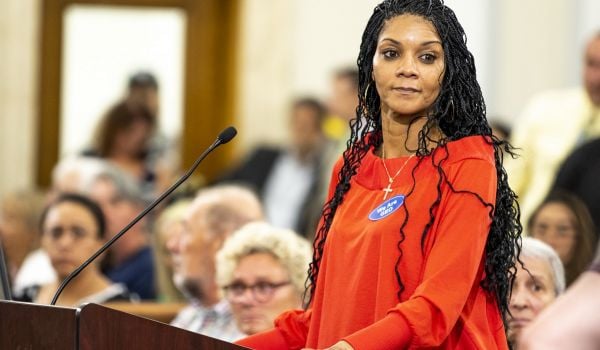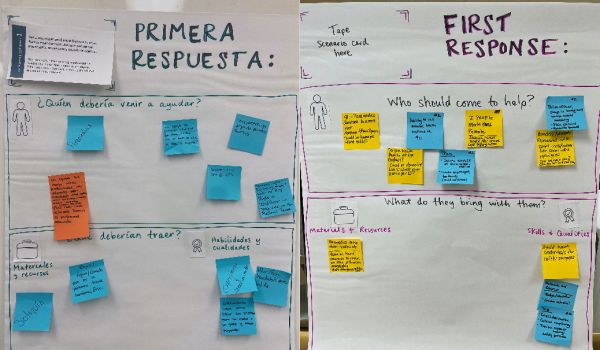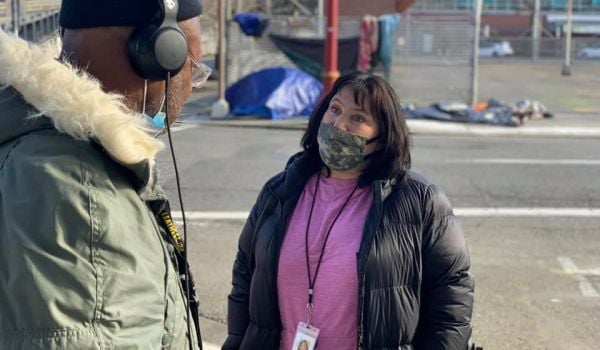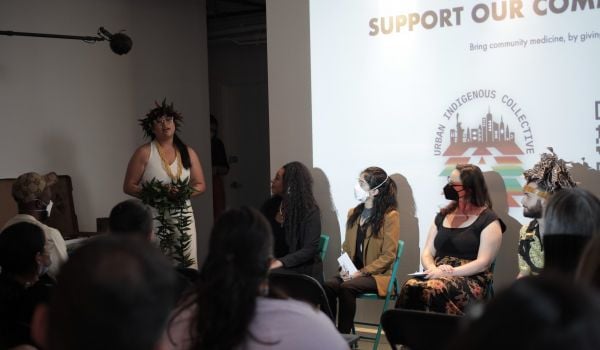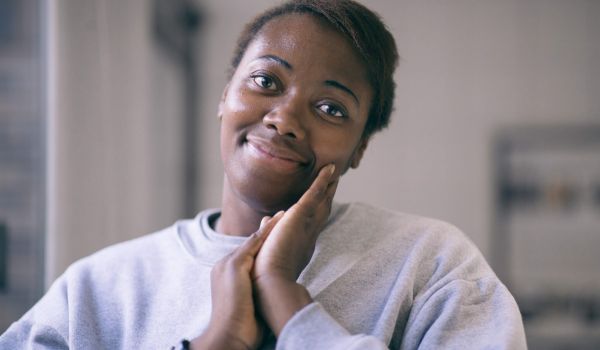Shawanna Vaughn fights prisons with equal amounts of forgiveness and fury. The forgiveness she offers is one that she hopes everyone will embrace — one that sees people who have committed harm as wounded, not evil, and that can become the basis for prioritizing healing over punishment.
She even extends forgiveness to the man who killed her brother.
“Why not?” she says. “It’s not the norm. How about we try something else? How about we try the thing that’s never tried?”
Vaughn reserves her fury for the prison system as a whole, one that torments those wounded people further, releasing them in worse condition than when they entered, if they’re released at all. She’s been there too, having spent five years in prison herself.
Through her small nonprofit Silent Cry, Vaughn battles that system — one often unwelcoming or even hostile to ideas of forgiveness — to change it radically. While education, housing, and employment have long made up the pillars of reentry, Vaughn is among a growing movement of formerly incarcerated people who see this list as incomplete.
“If we don’t deal with the mental health aspect of it, what good is [having a] job?” says Mannie Thomas, co-executive director and director of programming for the transformative justice organization Success Stories, and previously incarcerated himself. “[We’re talking about] dealing with the root problem so that I can maintain the job, so that I can maintain healthy relationships, so that I can be part of the community.”
Advocates like Vaughn and Thomas survived prison’s harms and the lack of non-carceral options available in Black communities specifically. For them, fighting incarceration means draining the U.S. prison system of its fuel: trauma. To do it, they’re supplementing traditional resources with mental health care before, during, and after incarceration, using their experiences to change lives through mutually beneficial approaches. Their aim, Vaughn says, is saving generations of children — particularly Black children — from “the cage and the grave.”
The connection between trauma and incarceration runs deep. A 2016 study found that people reporting four or more traumatic experiences were five times more likely to be incarcerated than those reporting none. Around 30-60% of incarcerated men exhibit PTSD symptoms, and a 2020 Urban Institute study found the same for more than 50% of women. The harm, perpetuated both by other incarcerated people and staff, only continues inside prison walls.
“Nothing about [prison] is rehabilitative,” Vaughn says. “It is human carnage. You might go there whole, and you come out fractured and broken.”
Yet there’s growing evidence that programs confronting trauma can transform behaviors in both currently and formerly incarcerated people. This is particularly true when they’re peer-led, and when those receiving services work with credible partners who deeply understand them. The service providers themselves interrupt cycles of harm while making a living amends.
This healing loop has a strong psychological basis, rooted in ideas like helper therapy, creative restitution and the “wounded healer” — a Jungian theory suggesting that mental health providers seek out the profession in part due to their own wounds.
Dr. Thomas LeBel, chair and associate professor at the University of Wisconsin-Milwaukee’s Department of Criminal Justice and Criminology, has studied this idea of a healing loop. Surveying formerly incarcerated service providers at New York reentry organizations, he found increased life and relationship satisfaction, and decreased feelings of personal stigma and fear of rearrest.
“They’re not just talking the talk, they’re walking the walk,” LeBel says. “It’s everything you could want…. The main point [is], and I’m not the first person to say [it]: encourage the systems to allow this to occur.”
Personal experience can impart a sense of courage and duty says Dr. Coralanne Griffith-Hunte, a colleague of Vaughn’s and a human, industrial and trauma psychologist.
Formerly incarcerated people can, “become now this ‘hope-ambassador’ to try to speak to those going through [trauma] to say, ‘Listen, our experience will not be the same, but I want you to know you’re not alone, this is what helped me, it may help you. I’m willing to offer you the information from my lived experience.’”
One such “hope ambassador,” Clover Perez, used her experience to found A Beautiful Heart Ministries. During her own incarceration, Perez was shocked to see high recidivism rates, with women released and returning, churning through the system in cycles of trauma, grief and harm.
Shortly before her incarceration, Perez’s son was murdered. As she mourned, she found that helping women on the inside to grow healthier became her purpose.
“I kept asking God, ‘Why? Why did you take my son?’” says Perez. “And I heard it so clearly. I was on my knees praying and I was crying, and I heard the voice that said, ‘I took one so you can help save many.’”
Now Perez’s work happens through ABHM, a Long Island-based nonprofit, built on a series of curricula tailored to formerly incarcerated women. These range from workshops called ‘She Writes Her Trauma,’ in which women pen letters to a humanized version of their trauma, to an immersive six-month cohort during which multiple facilitators address spirituality, life skills and mental health. Though small, ABHM works both independently and with partners like the Brooklyn District Attorney.
“I said, ‘You know what? I will not waste my trauma. If I have to go through this, I better, at the end of the day, have something to show for it,’” says Perez. “Going into prison and seeing so many women suffering… I made a conscious choice. I wanted to go through the pain. I wanted it to count for something.”
For Dr. Griffith-Hunte, this communal journeying is ideal. Healing, she says, “looks like empathy, not just expressing it to someone, but being empathetic to ourselves.” She adds, “understanding that healing isn’t just for that person over there but that I can get it too [by] being honest, being accountable.”
Ucedrah Osby found such reciprocal healing inside prison, though not during her own incarceration. Osby chanced upon a flier at a parole check-in for substance abuse counseling classes through a local university. In 2015, she took those skills— and her story — into group sessions at a men’s prison.
“Initially, I was fearful,” recalls Osby, now the president of the Bakersfield, California chapter of All of Us or None, “because either you’re gonna get critiqued [by those in the prison], or you’re gonna get people who just don’t say anything. You don’t know what that’s gonna do to your group.”
Having lived it, Osby understands their skepticism. They don’t need theory, she says — they need a new way of living.
“Let’s say I’m selling drugs,” she says, putting herself in the shoes of the men she is helping. “When it’s time for me to have a conversation about me wanting to do something else, I need to know you were in my shoes. I need to know you were down and dirty, just like how I was, because your story, the tools that you used, are gonna be the ones that I’m gonna use because I know that they worked. You’re here. You’re living proof.”
Over time, offering herself as “living proof,” of recovery, the men’s skepticism blossomed into openness that aided Osby’s own healing. “I’m not completely healed and it’s been about 20 years,” says Osby. “It’s a process, but I’m a lot closer than I was.”
While research remains scarce on small-scale organizations like Vaughn’s and Perez’s, that’s not the case for the work of Dr. Stephanie Covington, a clinician and author. Covington was working in addiction recovery when she met a prison warden at a conference in the 1980s. At that time, she was redesigning women’s treatment at the Betty Ford Center — a “plum job” she says. Hearing about the need for services, Covington persuaded the warden to let her spend “a couple days” in the prison.
“It changed the trajectory of my work,” she recalls. “I came out of there thinking, ‘This is my work to do.’”
Since then, Covington has created a variety of programs for both inside and outside prisons centered on changing behavior by addressing trauma. While she isn’t formerly incarcerated herself, she sees peer co-facilitation as one way to increase the success of a program. Working with a group of around 25 incarcerated women, Covington workshopped what would eventually become her curricula.
“I would start developing exercises because all the curricula had interactive exercises, and then we would do it. I’d say, ‘Ok I came up with this exercise. What do you think?’ And sometimes [the incarcerated women] would say ‘Stephanie that’s just awful and ridiculous.’ Or they’d say, ‘That’s really powerful. Keep that.’”
Working with women inside prison, “it became clear to me that any program addressing the violence women had committed would also need to address the aggression and violence they had personally experienced,” she wrote in a newsletter describing the results of her work.
Her bedrock program, Beyond Violence, is now used in women’s prisons in multiple countries and has been successfully adapted to men’s prisons, with studies showing notable reductions in depression, PTSD symptoms, anger and aggression, and more.
Liz Campbell was offered Beyond Violence in solitary confinement. Like many on the inside, she was not rehabilitated by prison, and she found herself replicating the patterns that landed her there. But BV clicked.
“It saved my life,” she said bluntly. “I had never heard this information before. Ever. Anywhere.”
BV allows people to understand “how they got there,” Campbell says, by examining the interactions between their inner life and their communities, relationships, and societal systems. Freed of shame, judgment, and punishment, incarcerated participants find meaning in their story and choice in their behavior. Those revelations unlock different ways of living.
Campbell became a BV peer facilitator while inside prison, a process that helped her break harmful cycles while helping others do the same. “Being able to examine all those aspects [of one’s life], one is able to peel the layers back,” she explains. “When a person looks at that and is able to put those pieces together… they’re able to understand how they became who they became, and then what is it going to take to become who they want to become.”
Thomas’s organization, Success Stories functions similarly. Incarcerated men meet for one 2-hour session weekly for 12 weeks. Working in small groups, they investigate the personal impacts of toxic masculinity. According to Thomas, they develop both “emotional capacity” and connect their attitudes to life goals. Facilitators provide the space and safety for reflection and vulnerability—opportunities that are painfully uncommon in prison.
The program has had such a successful track record that it has grown from one California prison to eleven, and Thomas says he sees participants changing dramatically, embracing complicated and vulnerable parts of themselves and each other.
“People try to say that’s utopian,” he says. “Alright, well tell me that when you have a Black gang member and a White supremacist walking the yard together having a conversation. You can’t tell me that’s utopian when I’m watching it.”
Still, he admits results are hard to quantify. Funding for programs is sparse, and funding to study them is almost nonexistent.
Added to that, the work is slow and often hard to scale. Despite showing success, even accessing prisons remains a barrier. Prison rules can prevent previously incarcerated people from coming back as service providers. On a personal level, regularly exploring trauma can be exhausting and painful.
The extra layer of connection, so useful in helping people relate, can also backfire. “The flip side that I’ve seen at programs, because so many people have had substance use issues,” LeBel observes, is “if [a provider] relapses or does get arrested for another crime. That can be pretty devastating.”
Those who see the value in such programs don’t shy away from these challenges. They see them as part of a decades-long struggle against a merciless system. “You always hear financial advisors talking about legacy wealth, legacy building,” Vaughn says. “To me… legacy building is making sure five generations of Black children after me will not see prison.”
Vaughn’s advocacy has birthed a bill, sponsored, but still sitting in committee in the New York State Legislature. If passed, it would require a “comprehensive, dynamic and individualized case management plan” for everyone in NY prisons, she explains. Reentry planning would begin within one week, and the Department of Corrections would have to publish an annual progress report.
The bill itself exists as a metaphor for change. Assembly Bill A6144 could entirely redesign mental health in New York prisons. If passed, it would do so as the “Post-traumatic prison disorder Shawanna W76337 act” — Vaughn’s prison ID number.
“Overcoming systemic -isms and ills is hard work, it’s painful,” says Vaughn. But, “the outcome of creating healthier people for tomorrow is worth it.”
This story was originally published by Yes! Magazine and appears here as part of the SoJo Exchange from the Solutions Journalism Network, a nonprofit organization dedicated to rigorous reporting about responses to social problems.Allen Arthur is a NYC-based journalist working mainly with people who are or have been incarcerated. He's also the online engagement manager for the Solutions Journalism Network.



